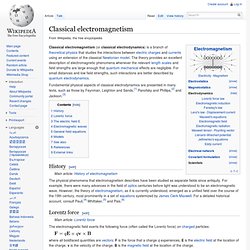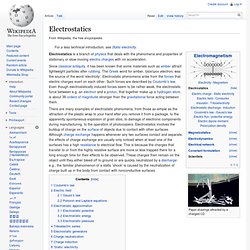

Optics. Optics is the branch of physics which involves the behaviour and properties of light, including its interactions with matter and the construction of instruments that use or detect it.[1] Optics usually describes the behaviour of visible, ultraviolet, and infrared light.

Because light is an electromagnetic wave, other forms of electromagnetic radiation such as X-rays, microwaves, and radio waves exhibit similar properties.[1] Some phenomena depend on the fact that light has both wave-like and particle-like properties. Explanation of these effects requires quantum mechanics. When considering light's particle-like properties, the light is modelled as a collection of particles called "photons". Quantum optics deals with the application of quantum mechanics to optical systems. Optical science is relevant to and studied in many related disciplines including astronomy, various engineering fields, photography, and medicine (particularly ophthalmology and optometry).
History[edit] . Where. Maxwell's equations. Maxwell's equations are a set of partial differential equations that, together with the Lorentz force law, form the foundation of classical electrodynamics, classical optics, and electric circuits.

These fields in turn underlie modern electrical and communications technologies. Maxwell's equations describe how electric and magnetic fields are generated and altered by each other and by charges and currents. They are named after the Scottish physicist and mathematician James Clerk Maxwell, who published an early form of those equations between 1861 and 1862. The equations have two major variants. The "microscopic" set of Maxwell's equations uses total charge and total current, including the complicated charges and currents in materials at the atomic scale; it has universal applicability but may be unfeasible to calculate.
The term "Maxwell's equations" is often used for other forms of Maxwell's equations. Formulation in terms of electric and magnetic fields[edit] Flux and divergence[edit] Magnetism. A magnetic quadrupole Magnetism is a class of physical phenomena that includes forces exerted by magnets on other magnets.
It has its origin in electric currents and the fundamental magnetic moments of elementary particles. These give rise to a magnetic field that acts on other currents and moments. All materials are influenced to some extent by a magnetic field. The strongest effect is on permanent magnets, which have persistent magnetic moments caused by ferromagnetism. The magnetic state (or phase) of a material depends on temperature (and other variables such as pressure and the applied magnetic field) so that a material may exhibit more than one form of magnetism depending on its temperature, etc.
History[edit] In ancient China, the earliest literary reference to magnetism lies in a 4th-century BC book named after its author, The Master of Demon Valley (鬼谷子): "The lodestone makes iron come or it attracts it Michael Faraday, 1842. Electricity. Classical electromagnetism. Classical electromagnetism (or classical electrodynamics) is a branch of theoretical physics that studies the interactions between electric charges and currents using an extension of the classical Newtonian model.

The theory provides an excellent description of electromagnetic phenomena whenever the relevant length scales and field strengths are large enough that quantum mechanical effects are negligible. For small distances and low field strengths, such interactions are better described by quantum electrodynamics. Fundamental physical aspects of classical electrodynamics are presented in many texts, such as those by Feynman, Leighton and Sands,[1] Panofsky and Phillips,[2] and Jackson.[3] History[edit] The physical phenomena that electromagnetism describes have been studied as separate fields since antiquity. Lorentz force[edit] The electromagnetic field exerts the following force (often called the Lorentz force) on charged particles: The electric field E[edit] where Models[edit]
Electrostatics. Paper shavings attracted by a charged CD Electrostatics is a branch of physics that deals with the phenomena and properties of stationary or slow-moving electric charges with no acceleration.

Since classical antiquity, it has been known that some materials such as amber attract lightweight particles after rubbing. The Greek word for amber, ήλεκτρον electron, was the source of the word 'electricity'. Electrostatic phenomena arise from the forces that electric charges exert on each other. Such forces are described by Coulomb's law. Coulomb's law[edit]